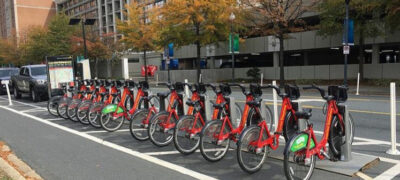New Fare Payment Systems and Payment Technology Best Practices and Recommendations
- Date: November 9, 2022
Jump to section
Using technology for fares can advance agency goals and provide an added convenience for transit riders. This guidebook provides information on the different types of fare systems and fare payments that can work within the chosen system. Additionally, decisions about fare policies can influence decisions about systems and payments but can also be used to center the use of fare technology around maximizing usage for riders. The timeline from exploration to deployment outlined a few considerations for each stage of the process. Specific recommendations may vary from agency to agency and are constrained by the goals an agency is trying to achieve, resources (e.g., financial or staff) available, and existing fare options. Fare technology should be used in tandem with other fare types to ensure riders have flexibility, convenience, and maximizing access.
Best Practices for Fare Technology
For Contactless Cards (EMV)
- Supports Visa, Mastercard, and Discover payment methods.
- Utilizes fare aggregation of transactions instead of micropayment transactions that report individual, smaller fares.
- Allows unbanked users to utilize EMV technology through prepaid cards found at retail locations or through payment processors such as CashApp or Venmo.
- Identify if the financial institution or the transit agency will absorb the first ride risk.
- Ensure compliance with PCI DSS.
- Outline in the contract who is responsible for merchant fees.
For Smart Cards
- Establish partnerships with retailers to allow cash users to load stored values on cards.
- Avoid setting high reload values for smart cards to promote maximizing usage perhaps only requiring the cost of one fare. Agencies should work with community members to determine the right amount.
- Consider offering transit rewards or other promotions when riders use smart cards.
- Decide if the smart cards will allow for account-based back-end administration.
Mobile Ticketing
- Determine the type of validation:
- If using visual validation, train operators to identify fraudulent tickets
- If using a validator, select the preferred type (i.e., proximity or NFC/Bluetooth)
- Deploy security measures to avoid fraud, such as unique ticket branding, scrolling images, or specific colors.
- Establish a policy to allow riders to board vehicles without requiring cellular service to activate.
- Select a vendor that meets your specific needs with either simple integrations or complex integrations, including micromobility or transportation network companies.
- Consider allowing institutional partners access to back-end systems to manage unique riders via the third party to reduce the administrative burden.
Establish Agency Goals
- Set agency goals to guide the planning, procurement, selection, and deployment of the fare technology.
- Align goals with agency policies, priorities, capital needs, and rider demographics.
Consider Leveraging a Joint Procurement
- Collaborative procurement with other agencies in the region can be helpful in managing complex technologies, attracting and improving negotiations with vendors, and can lead to a stronger financial arrangement and cost-efficiency.
Incentivizing Ridership
- Riders may be unbanked, underbanked, or without access to a cellphone. If the fare technology only offers riders an alternative way to pay for fares, then continue to provide alternative fare options to ensure access; To maximize service ensure access to the technology.
Carefully Evaluate Vendors and the Technology Offered
- Identify any potential costs, fee structures, and time commitments.
- Verify that the technology is market-tested and available.
- Outline specific agency needs that need to be met by the vendor (i.e., vehicle equipment, customer service support, data requirements).
Select Fare Technology to Meet Data Needs and Requirements
- Ensure any data collected meet agency goals or Federal reporting requirements.
- Utilize a user-friendly back-end system that can integrate with the existing IT system.
- Confirm back-end system allows for data reconciliations needed for auditing purposes.
Utilize an Evaluation Strategy for Selecting Fare Systems and Fare Payments
- For fare payments, consider the evaluation matrix for compatibility between fare types required by the agency and the type of fare payment, as shown in the next table.
- When determining which fare technology consider utilizing an evaluation strategy to consider a low, medium, or high level of complexity relative to capital cost and a low, medium, or high level of effort at the agency level relative to operating costs. Examples of these evaluation strategy matrices are shown in the second and third tables.
| Fare Types | Contactless EMV Cards | Smart Cards | Mobile Ticketing |
| Full Fare | 5 | 5 | 5 |
| Passes | 1 | 4 | 5 |
| Reduced Fares | 1 | 3 | 4 |
| Institutional Fares/Passes | 1 | 4 | 3 |
| Zonal/Distance-Based Fares | 2 | 2 | 3 |
| Fare Capping | 2 | 5 | 5 |
| Trip Planning | 0 | 0 | 4 |
| Transit Rewards | 0 | 4 | 4 |
| Retail Partnerships | 4 | 3 | 4 |
Matrix Legend:
0 = Not applicable
1 = Hard to implement
2 = Somewhat hard to implement
3 = Neutral
4 = Somewhat straightforward to implement
5 = Straightforward to implement
| Low Capital Cost | Medium Capital Cost | High Capital Cost | |
| Low Complexity |
|
|
|
| Medium Complexity |
|
|
|
| High Complexity |
|
|
|
| Low Operating Cost | Medium Operating Cost | High Operating Cost | |
| Low Level of Effort |
|
|
|
| Medium Level of Effort |
|
|
|
| High Level of Effort |
|
|
|

